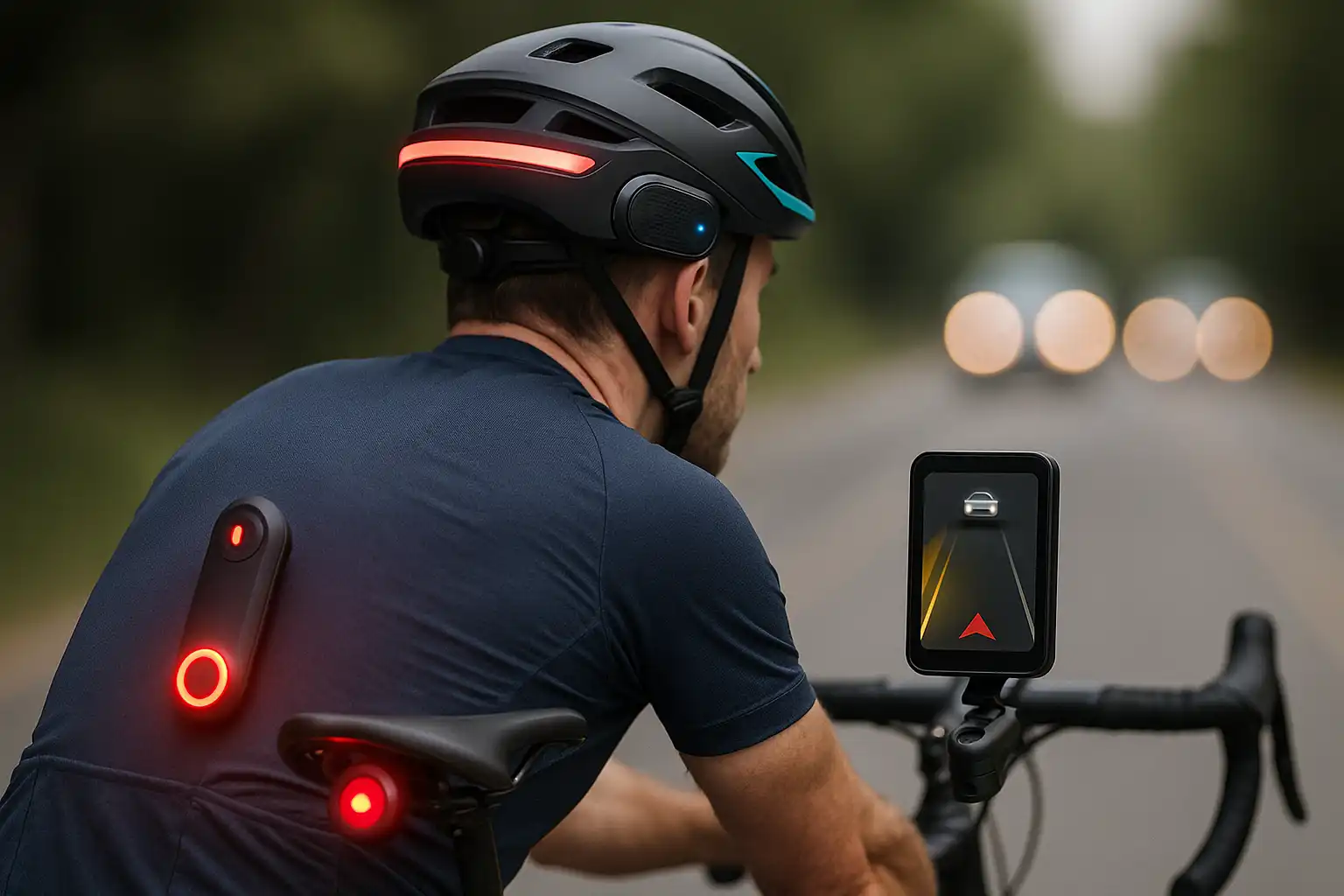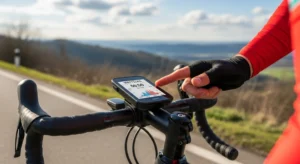The landscape of cycling safety is being transformed by revolutionary technology that’s making riding safer than ever before. In 2025, cyclists have access to an unprecedented array of smart safety devices, communication systems, and protective technologies that can detect threats, prevent accidents, and provide emergency assistance when needed. These innovations represent a fundamental shift from passive safety equipment to active, intelligent systems that work continuously to protect riders.
The integration of advanced sensors, artificial intelligence, and communication technologies is creating a new paradigm in cycling safety. Modern safety systems don’t just protect cyclists when accidents occur—they actively work to prevent accidents from happening in the first place. This proactive approach to safety is revolutionizing how we think about cycling protection and making cycling accessible to riders who might otherwise be concerned about safety risks.
## Radar Technology: Eyes in the Back of Your Head
Bike radar systems have emerged as one of the most significant safety innovations in cycling technology. These compact devices use radar waves to detect approaching vehicles from behind, providing cyclists with advance warning of potential threats. Modern radar systems can detect vehicles up to 140 meters away and track multiple vehicles simultaneously, giving cyclists crucial seconds to react to dangerous situations.
The integration of radar systems with bike computers and smartphone apps provides real-time visual and audible alerts about approaching traffic. Many systems use color-coded displays that show the relative speed and distance of approaching vehicles, allowing cyclists to make informed decisions about lane positioning and defensive riding strategies.
Advanced radar systems can differentiate between different types of vehicles and assess threat levels based on speed, trajectory, and proximity. Some systems can even predict potential collision scenarios and provide escalated warnings when immediate evasive action may be necessary.
The reliability and accuracy of modern bike radar systems have improved dramatically, with advanced signal processing algorithms that can filter out false positives from stationary objects, other cyclists, and environmental factors. This reliability is crucial for user acceptance and ensures that cyclists receive meaningful warnings without being overwhelmed by unnecessary alerts.
Battery life and weather resistance have also improved significantly in modern radar systems. Many devices can operate for 15-20 hours on a single charge and are designed to function reliably in all weather conditions, making them practical for daily use and long-distance riding.
## Smart Helmet Technology: Protection Meets Intelligence
Smart helmets represent the convergence of traditional protective equipment with advanced technology, creating head protection that goes far beyond impact absorption. Modern smart helmets incorporate features like integrated lighting, communication systems, crash detection, and even heads-up displays that provide navigation and performance information.
Crash detection technology in smart helmets uses accelerometers and gyroscopes to detect sudden impacts or unusual motion patterns that indicate a crash has occurred. When a crash is detected, these systems can automatically send emergency alerts to predetermined contacts, including GPS location information and medical details that could be crucial for first responders.
Integrated lighting systems in smart helmets provide 360-degree visibility, with front lights for illumination and rear lights for visibility to following traffic. Many systems include turn signals that can be activated by hand gestures or bike computer controls, providing clear communication of the cyclist’s intentions to other road users.
Communication features in smart helmets allow cyclists to take phone calls, listen to navigation instructions, and even communicate with other cyclists in group rides without removing their hands from the handlebars. Advanced noise cancellation technology ensures clear communication even in windy conditions or heavy traffic.
Some smart helmets include heads-up display technology that projects information directly into the cyclist’s field of view. This technology can display navigation directions, performance metrics, and safety alerts without requiring the cyclist to look away from the road.
## Vehicle-to-Everything (V2X) Communication
Vehicle-to-Everything (V2X) communication technology represents the future of road safety, enabling bicycles, vehicles, and infrastructure to communicate with each other in real-time. This technology creates a connected ecosystem where all road users are aware of each other’s presence, intentions, and potential conflicts.
V2X systems for cyclists typically include small communication devices that broadcast the cyclist’s position, speed, and direction to nearby vehicles equipped with compatible technology. Similarly, these devices can receive information from vehicles and infrastructure, providing cyclists with warnings about potential hazards, traffic conditions, and road situations.
The integration of V2X technology with existing cycling safety systems creates comprehensive situational awareness that goes far beyond what any single sensor or device can provide. Cyclists can receive warnings about vehicles approaching from blind spots, traffic signal timing, road construction, and other hazards that might not be immediately visible.
Infrastructure integration is a key component of V2X systems, with traffic signals, road signs, and other infrastructure elements capable of communicating directly with cyclists. This communication can provide information about signal timing, pedestrian crossing phases, and even optimal speeds for hitting green lights.
The standardization of V2X communication protocols is enabling interoperability between different manufacturers and systems, creating a unified safety ecosystem that benefits all road users. As more vehicles and infrastructure elements become V2X-enabled, the safety benefits for cyclists will continue to grow.
Emergency vehicle integration is another important application of V2X technology, with ambulances, fire trucks, and police vehicles able to communicate their presence and intended routes to cyclists and other road users. This advance warning can help cyclists move safely out of the way and avoid dangerous situations.
## Artificial Intelligence and Predictive Safety
Artificial intelligence is playing an increasingly important role in cycling safety technology, enabling systems to learn from patterns, predict potential hazards, and provide proactive safety interventions. AI-powered safety systems can analyze vast amounts of data from sensors, cameras, and communication systems to identify potential risks before they become dangerous situations.
Machine learning algorithms can analyze riding patterns, traffic conditions, and environmental factors to predict when and where accidents are most likely to occur. This predictive capability allows safety systems to provide early warnings and suggest alternative routes or riding strategies to avoid high-risk situations.
Computer vision technology integrated with AI can identify and classify different types of road hazards, from potholes and debris to pedestrians and vehicles. These systems can provide real-time warnings about road conditions and help cyclists navigate safely around obstacles.
Behavioral analysis using AI can detect when cyclists are riding in ways that increase accident risk, such as following too closely, riding in blind spots, or making sudden movements. These systems can provide gentle coaching and feedback to help cyclists develop safer riding habits.
The integration of AI with other safety technologies creates synergistic effects that enhance overall safety performance. AI can optimize the sensitivity and response of radar systems, improve the accuracy of crash detection algorithms, and coordinate multiple safety systems to provide comprehensive protection.
## Anti-Theft and Security Technology
Bike theft remains a significant concern for cyclists, and advanced security technology is providing new solutions to protect valuable bicycles and equipment. Smart locks with GPS tracking, alarm systems, and smartphone integration are making it much more difficult for thieves to successfully steal bikes.
GPS tracking systems integrated into bikes or accessories allow owners to locate stolen bikes and provide law enforcement with real-time location information. Some systems include geofencing capabilities that send alerts when bikes are moved outside of designated safe areas.
Smart alarm systems can detect tampering, movement, or unauthorized access attempts and respond with loud alarms, smartphone notifications, and even automatic contact with security services. Advanced systems can differentiate between normal handling and theft attempts, reducing false alarms while maintaining security.
Blockchain technology is being used to create tamper-proof ownership records and registration systems that make it easier to prove ownership and more difficult to sell stolen bikes. These systems can also facilitate insurance claims and recovery efforts when theft does occur.
Integration with bike-sharing and rental systems is creating comprehensive security ecosystems that protect both individual and fleet bicycles. These systems can track usage patterns, detect anomalies, and coordinate with law enforcement when necessary.
## Emergency Response and Medical Technology
Advanced emergency response technology is providing cyclists with unprecedented access to help when accidents or medical emergencies occur. Automatic crash detection systems can summon emergency services even when cyclists are unconscious or unable to call for help themselves.
Medical information storage and transmission systems allow emergency responders to access critical medical information about injured cyclists, including allergies, medications, and emergency contacts. This information can be stored on smart devices or in cloud-based systems that are accessible to authorized emergency personnel.
Satellite communication devices provide emergency communication capabilities even in areas without cellular coverage, ensuring that cyclists can call for help regardless of their location. Many devices include SOS features that can summon emergency services with the press of a button.
Integration with emergency medical services is improving response times and outcomes for cycling accidents. Some systems can provide emergency dispatchers with detailed information about the accident location, the cyclist’s condition, and the best access routes for emergency vehicles.
Telemedicine capabilities are being integrated into some cycling safety systems, allowing cyclists to consult with medical professionals remotely when injuries or medical issues occur during rides. This capability can be particularly valuable for cyclists in remote areas or during long-distance events.
## Visibility and Lighting Innovation
Advanced lighting technology is dramatically improving cyclist visibility and safety, with smart lighting systems that adapt to conditions and provide optimal illumination and visibility in all situations. Modern cycling lights use LED technology, smart sensors, and connectivity features to provide superior performance compared to traditional lighting systems.
Adaptive lighting systems automatically adjust brightness and beam patterns based on ambient light conditions, speed, and riding environment. These systems can provide focused beams for high-speed riding and wide, diffused light for urban environments, optimizing visibility for both the cyclist and other road users.
Daytime running lights specifically designed for cycling provide enhanced visibility during daylight hours when traditional lights may not be effective. These lights use specific wavelengths and patterns that are particularly visible to the human eye during daylight conditions.
Integration with other safety systems allows lighting to respond to detected threats or hazards. For example, lights can flash or change patterns when radar systems detect approaching vehicles, or when navigation systems indicate upcoming turns or hazards.
Wearable lighting systems integrated into clothing, helmets, and accessories provide 360-degree visibility and can be customized for different riding conditions and preferences. Some systems include gesture control features that allow cyclists to activate turn signals or emergency flashers with simple hand movements.
## Data Analytics and Safety Insights
The collection and analysis of safety data from cycling technology systems is providing valuable insights into accident patterns, risk factors, and effective safety interventions. This data is helping manufacturers improve their products and helping cyclists make informed decisions about routes, timing, and safety equipment.
Crowdsourced safety data from connected cycling devices is creating comprehensive databases of road conditions, hazard locations, and accident hotspots. This information can be used to improve infrastructure planning, identify high-risk areas, and provide real-time safety information to other cyclists.
Personal safety analytics can help individual cyclists understand their own risk patterns and identify opportunities for improvement. These systems can track near-miss events, analyze riding behavior, and provide personalized safety recommendations.
Integration with municipal and transportation planning systems is helping cities use cycling safety data to improve infrastructure and reduce accident rates. This data-driven approach to safety planning is leading to more effective interventions and better outcomes for all road users.
## The Future of Cycling Safety Technology
Looking ahead, cycling safety technology will continue to evolve and become more sophisticated, with advances in sensor technology, artificial intelligence, and communication systems creating even more effective safety solutions. The integration of multiple technologies into comprehensive safety ecosystems will provide cyclists with unprecedented protection and situational awareness.
Autonomous vehicle integration will create new opportunities for cycling safety, with self-driving cars specifically programmed to detect and safely interact with cyclists. The communication between autonomous vehicles and cycling safety systems could virtually eliminate many types of vehicle-cyclist accidents.
Augmented reality technology may eventually provide cyclists with enhanced situational awareness through smart glasses or helmet displays that overlay safety information onto the real world. This technology could highlight potential hazards, provide navigation guidance, and display real-time safety alerts.
The continued miniaturization and cost reduction of safety technology will make advanced safety systems accessible to more cyclists, potentially making sophisticated safety features standard equipment rather than premium options.
## Choosing and Using Safety Technology
For cyclists considering safety technology investments, it’s important to prioritize systems that address the most common and serious safety risks. Visibility enhancement, collision avoidance, and emergency communication are typically the most valuable safety investments for most cyclists.
Integration and compatibility between different safety systems can significantly enhance their effectiveness. Choosing systems that work together and share information can provide more comprehensive protection than individual devices operating independently.
Regular maintenance and updates are crucial for safety technology effectiveness. Keeping software updated, batteries charged, and sensors clean ensures that safety systems function properly when they’re needed most.
Training and familiarization with safety technology features and operation is essential for maximizing their benefits. Understanding how systems work and practicing their use in safe environments helps ensure effective use during actual emergencies or dangerous situations.
## Conclusion: A Safer Future for Cycling
The cycling safety technology revolution of 2025 is making cycling safer and more accessible than ever before. The combination of advanced sensors, artificial intelligence, communication systems, and protective equipment is creating a comprehensive safety ecosystem that actively works to prevent accidents and protect cyclists when incidents do occur.
As these technologies continue to evolve and become more affordable, they have the potential to dramatically reduce cycling accident rates and encourage more people to choose cycling as a safe and practical transportation option. The integration of cycling safety technology with broader transportation and infrastructure systems will create even more comprehensive safety solutions in the future.
For cyclists, the availability of advanced safety technology provides new opportunities to ride with confidence and peace of mind. Whether commuting in busy urban environments or exploring remote areas, modern safety technology can provide valuable protection and assistance that enhances the cycling experience while reducing risks.
The continued development and adoption of cycling safety technology represents a significant step forward in making cycling a safer, more accessible, and more enjoyable activity for people of all ages and abilities.




